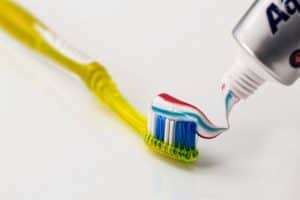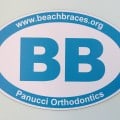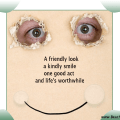7 Tips for Brushing Your Teeth [with Braces]
Last Updated on April 3, 2019 by Guest Post
There are some people who were born with perfect teeth, and unfortunately, there are some people who weren’t. If your child has an overbite, an underbite, crowded teeth, or gaps in their teeth, you should make an appointment for a consultation with an orthodontist. In most cases, they will recommend braces for your child.
Before your child has them put on, you should understand that there are several things that your child will need to do to keep their braces from being damaged and to keep their teeth healthy. Brushing their teeth is one of these things. If your child neglects their oral health or if they don’t brush their teeth correctly, it can result in tooth decay or permanent stains on their teeth. Below are 7 steps that your child should follow when brushing their teeth.
Step 1-Start With Water
Before your child starts brushing their teeth they should first rinse their mouth out with water. Rinsing will help to loosen up any food that is stuck under the brackets and the wires. This will make brushing more effective. If your child rinses their mouth and they spit food particles in the sink, they should rinse again. They should do this until the water is clear when they spit. When the water is clear, your child can start brushing.
Step 2-Use the Right Toothpaste
There are plenty of kinds of toothpaste on the market that tastes good. Some taste like bubblegum and some taste cherries and many other flavors. While these kinds of toothpaste may taste good, they won’t always do a good job. These types of toothpaste are fine for young children, however, when your child gets older, they need to start using a more effective toothpaste. When choosing your child’s toothpaste, you should make sure that you are choosing something that has been recommended by the American Dental Association (ADA). If you aren’t sure if the toothpaste is recommended by the ADA, it will be printed right on the tube.
Step 3-Start By Brushing at an Angle
When your child first starts brushing their teeth, they should do so an angle. If they brush at a 45-degree angle, they will be able to brush the upper part of their gums rather than just the lower part. A huge part of a healthy smile is healthy gums. Brushing the gums correctly is the best way to keep them healthy.
Step 4-Brush the Brackets Correctly
When your child is brushing their brackets, they need to focus on more than just the front of the brackets. It is important that they brush behind the brackets as well because this is where food and debris like to hide. When they brush the brackets on the top, they should angle the toothbrush downward on the top of the brackets. When they brush the bottom brackets, they should do the opposite and angle the toothbrush upwards. When the brackets are clean underneath, they can brush the top of the brackets.
Step 5-Brush Slowly
Most kids want to brush their teeth as quickly as possible so that they can get on with the rest of their day. This is one of the major reasons why kids going through orthodontic treatment have oral health issues. In order to get the food and debris off the teeth, your child needs to brush slowly and take the time necessary. Your child also needs to brush carefully around each bracket. If they don’t, it can result in permanent stains on their teeth. One good trick to get your child to brush for the appropriate amount of time is to have a song playing when they brush.
Most kids today have cell phones and most kids have music on their phone. Encourage your child to play a song while they brush and have them brush their teeth until the song ends. This will give your child something to focus on when they brush. Also, most songs last between two and three minutes, which is the length of time that they should be brushing their teeth.
Step 6-Floss
Whether a child is undergoing orthodontic treatment or not, they should be flossing twice a day. Most kids skip this step because it is a lot of work, also flossing around the wires can be difficult. Since there is a wire that goes across the middle of their teeth, your child won’t be able to floss the way that they always have. It is best to give your child a soft with and a floss threader.
During your child’s visit to the orthodontist, they will give your child a special tool to clean under the brackets. You should make sure that they use this as well. Using the special tool and the floss will keep your child’s gums healthy, which is imperative for good oral health.
Step 7-Rinse
When your child has finished brushing and flossing, they still aren’t done. They will need to rinse their mouth to remove the toothpaste and any food or debris that they removed during brushing and flossing, and rinsing with water isn’t enough. You should also keep a bottle of fluoride mouthwash in the bathroom. This will remove any plaque and debris from the teeth that your child may have missed. Also, it will help to prevent cavities. When rinsing with mouthwash, your child should swish it around in their mouth for about 30 seconds before spitting.
What’s the Bottom Line?
It is very important that you make sure that they brush/brushing their teeth properly when they are undergoing orthodontic treatment. They should brush in the morning, at night, and if possible, after eating. To ensure your child’s oral health, you should make sure that they make it to every scheduled appointment. At each appointment, the orthodontist will check your child’s progress, they will check for any damage to the bracket and the wires, and most importantly, they will check your child’s oral health.
If your child misses their scheduled appointment, it will only impede your child’s progress, resulting in them needing treatment for much longer than they should need to. For more information regarding your child’s treatment and proper brush/brushing techniques, contact Dr. Pannuci for an appointment.
Beach Braces Orthodontics
220 N. Aviation Blvd
Suite A
Manhattan Beach
CA 90266
Phone: (310) 379-0006
7 Tips for Brushing Your Teeth [with Braces]

Dr Patti Panucci attended the University of Louisville School of Dentistry for four years, where she graduated with a DMD degree (May 2000) among the Top 10 in her class. Following that, she headed west to Los Angeles to complete her three-year residency at one of the top-ranked orthodontic programs in the country – the University of Southern California.
Along with her certificate in orthodontics, Dr. Panucci earned a master’s degree in craniofacial biology. During those three years, she fell in love with Southern California beach life and decided that this was where her future lay.













Leave a Reply
Want to join the discussion?Feel free to contribute!